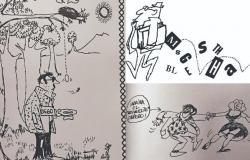Tuesday, June 11, 2024, 5:12 p.m.
| Updated 11:09 p.m.
Comment
Copy link
WhatsApp
Facebook
x
LinkedIn
Telegram
The Museum of Contemporary Art of Castilla y León (MUSAC) has inaugurated the three new exhibitions that will mark the museum’s summer season. ‘María Luisa Fernández. 8,068,807,215. Sangre en oro’ presents the most recent production by the Leonese artist; ‘Prudencio Irazabal. Contradistancia’ brings together a set of 32 paintings that span from the mid-nineties to the present; and ‘Pipilotti Rist. MUSAC’ Collection recovers two works by the video artist with which the Museum reopens its most monumental room. All of them can be seen until October 13.
‘María Luisa Fernández. 8,068,807,215. Sangre en oro ‘presents the most recent production of María Luisa Fernández (Villarejo de Órbigo, León, 1955), in her first solo exhibition in a museum in the last eight years. The artist continues her tireless search for a sculpture that can impact the emotions of viewers. In this way, she invites us to reflect beyond the experience at the exhibition site.
In this exhibition, curated by Sergio Rubira, the artist takes up one of the series on which she had already worked in the nineties, expands it by adding new layers of meaning and exploring other materialities. In the series ‘Ideal Artists’ she converted the geometric shapes of statistical pie charts into sculptural elements. Made of wood and painted in oil, these elements were placed on top of each other and, later, on foam mattresses.
In the MUSAC these sculptures hang from the ceiling and become burned ‘Ideal Artists’ because they are no longer painted, but rather the black color and iridescence are the result of the carbonization process that occurs when burning the surface of the wood with the that are done. «If in the nineties the ‘Ideal Artists’ referred to the way in which the idea of genius had been constructed and the way in which María Luisa Fernández positioned herself with respect to these stereotypes, now the questions include what the artists do. artists facing what is happening,” explains Sergio Rubira.
María Luis Fernández also presents a series of recent drawings in which the muscles and bones have disappeared and only the arteries and veins remain.
Room 3 of the MUSAC hosts ‘Prudencio Irazabal. Contradistancia’, an exhibition that, curated by Mariano Mayer, brings together a set of 32 pieces by the painter. Without a retrospective intention, the works made between 1995 and 2024 that make up the exhibition allow us to discover the visual variables shaped by the temporality of our attention.
The untitled paintings by Prudencio Irazabal (Puentelarrá, Álava, 1954) investigate the materiality of light, something that in his work appears, in a certain way, disintegrated. «Facing our body towards his works implies going through a series of transformations in which the possibility of naming a color, as it appears, disappears. In this sense, the longer the attention time, the greater the number of variables,” says Mariano Mayer.
Illusions of instability
The interest in constructing illusions of depth and perceptual instability overflows from frame to frame. In Irazabal’s work there is no linear development or analytical progression but rather the very idea of painting without finishing. However, these paintings are not unfinished. The large number of variables, obtained with a few elements, has allowed, after three decades of activity, thematic stability and variability of results.
Each painting by Prudencio Irazabal celebrates, in the artist’s words, the conjunction of “an instrument and a material in which to act” and reveals some of its purposes: that the plastic connotations move away from any type of explanatory intention and that the instrumental aspects are not obvious. To do this, the artist advises “looking inside more than at its surface.”
Color in motion
The exhibition ‘Pipilotti Rist. MUSAC Collection’ includes two video installations from the museum’s collections: ‘Homo sapiens sapiens 5 wings’ (2005), a piece that reopens Room 6, the most monumental with 14 meter high ceilings and which has been closed for the last 10 years, and ‘Apple Tree Innocent on Diamond Hill’ (2003), installed in Room 5.
Born Elisabeth Charlotte Rist, she is one of the most prominent artists of video art in the 90s and early 2000s. The language of Rist, who created her artistic alias in 1982 in reference to Pippi Longstocking, is characterized by the use of saturated, exuberant and excessive colors with which he manages to generate sensory spaces. In her moving work, moreover, the sensual is intertwined with the electronic and the natural with the technological.
Under the title ‘Apple Tree Innocent on Diamond Hill’, this installation is related to the Innocent Collection, a series that the artist began in 1985 by collecting translucent plastic pieces in which there is no type of color impression as a collaborative gesture. against the current of consumerism. Influenced by Fluxus and Yoko Ono, the elements of this work hang from the branch of a tree and are contrasted with video scenes of a coastal landscape filmed at twilight.
The second work, ‘Homo sapiens sapiens 5 wings’, is the multichannel version created by the artist for room 6 of the museum. This piece, hypnotic and suggestive, appeals to the senses and incorporates furniture designed by the artist to be able to see the projections in a state of sensory abandonment and sound and visual immersion.






